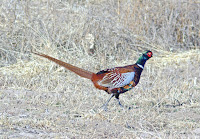RING-NECKED PHEASANT
RING-NECKED PHEASANT – (Phasianus colchicus) – (See images below)
DESCRIPTION: The Ring-necked Phaesant (or Common Phaesant) male displays several colors – iridescent dark green head and neck, red face, white neck ‘ring’ or band, gold body with black feather tips, and a black tail. Females blend in with the areas where they live and breed – beige tones with dark brown feather tips on the body. The male ring-necked pheasant is about 85 cm (33 in.) long including the tail, which is around 50 cm (20 in.) long. The female is shorter at around 60 cm (25 in.) in total length.
VOICE: https://www.xeno-canto.org/species/Phasianus-colchicus
NAME: The English name ‘Pheasant’ comes from Latin and means the same. The Latin species name ‘colchicus’ comes from the ancient name of Georgia, Colchis, the Asian country where this bird became known in Europe.
HABITAT: Varied – woodland, farmland, even wetlands.
DIET: The bird’s diet is diversified – insects and grains, small animals.
BREEDING/NESTING: As with other birds in that order, male ring-necked pheasants breed with several females and chase away other males from their ‘harem’. The nest is a scrape on the ground in a well-hidden area. An average of a dozen light green eggs are laid, which are incubated by the female. The female is the caring parent for the chicks.
DISTRIBUTION: The ring-necked pheasant is originating from Asia, but has been introduced as a game bird around the world. On Hawaii it was introduced in 1865, and is now common on all main islands.
Distribution map: https://en.wikipedia.org/wiki/Common_pheasant#/media/File:Phasianus_colchicus_map.svg
ON PEI: The ring-necked pheasant was introduced to Prince Edward Island as a game bird, and is now breeding successfully on the island.
CONSERVATION: Pheasants are a popular game bird and in some USA states several hundred thousand birds are ‘harvested’ each year. Many pheasants are bred on farms especially for hunting. There is a high mortality rate from vehicle collisions on roads. There has also been loss of its habitat from modern agricultural practices. In spite of these issues the species is currently not considered at risk.
NOTES: The ring-necked pheasant belongs to the same order as the chicken, the turkey, and the grouse. It roosts in trees. This bird has the capacity to stay ‘dormant’ for a few days during very cold spells in the winter. The ring-necked pheasant is the State Bird of South Dakota.
REFERENCES: https://www.allaboutbirds.org/guide/Ring-necked_Pheasant/id
https://www.audubon.org/field-guide/bird/ring-necked-pheasant
https://novascotia.ca/natr/wildlife/conserva/ring-necked-pheasant.asp
http://aep.alberta.ca/fish-wildlife/wild-species/birds/grouse-related-birds/pheasant.aspx
https://www.ct.gov/deep/cwp/view.asp?Q=326060
DESCRIPTION: The Ring-necked Phaesant (or Common Phaesant) male displays several colors – iridescent dark green head and neck, red face, white neck ‘ring’ or band, gold body with black feather tips, and a black tail. Females blend in with the areas where they live and breed – beige tones with dark brown feather tips on the body. The male ring-necked pheasant is about 85 cm (33 in.) long including the tail, which is around 50 cm (20 in.) long. The female is shorter at around 60 cm (25 in.) in total length.
VOICE: https://www.xeno-canto.org/species/Phasianus-colchicus
NAME: The English name ‘Pheasant’ comes from Latin and means the same. The Latin species name ‘colchicus’ comes from the ancient name of Georgia, Colchis, the Asian country where this bird became known in Europe.
HABITAT: Varied – woodland, farmland, even wetlands.
DIET: The bird’s diet is diversified – insects and grains, small animals.
BREEDING/NESTING: As with other birds in that order, male ring-necked pheasants breed with several females and chase away other males from their ‘harem’. The nest is a scrape on the ground in a well-hidden area. An average of a dozen light green eggs are laid, which are incubated by the female. The female is the caring parent for the chicks.
DISTRIBUTION: The ring-necked pheasant is originating from Asia, but has been introduced as a game bird around the world. On Hawaii it was introduced in 1865, and is now common on all main islands.
Distribution map: https://en.wikipedia.org/wiki/Common_pheasant#/media/File:Phasianus_colchicus_map.svg
ON PEI: The ring-necked pheasant was introduced to Prince Edward Island as a game bird, and is now breeding successfully on the island.
CONSERVATION: Pheasants are a popular game bird and in some USA states several hundred thousand birds are ‘harvested’ each year. Many pheasants are bred on farms especially for hunting. There is a high mortality rate from vehicle collisions on roads. There has also been loss of its habitat from modern agricultural practices. In spite of these issues the species is currently not considered at risk.
NOTES: The ring-necked pheasant belongs to the same order as the chicken, the turkey, and the grouse. It roosts in trees. This bird has the capacity to stay ‘dormant’ for a few days during very cold spells in the winter. The ring-necked pheasant is the State Bird of South Dakota.
REFERENCES: https://www.allaboutbirds.org/guide/Ring-necked_Pheasant/id
https://www.audubon.org/field-guide/bird/ring-necked-pheasant
https://novascotia.ca/natr/wildlife/conserva/ring-necked-pheasant.asp
http://aep.alberta.ca/fish-wildlife/wild-species/birds/grouse-related-birds/pheasant.aspx
https://www.ct.gov/deep/cwp/view.asp?Q=326060
 |
| Ring-necked pheasant, Alan Schmierer |
 |
| Ring-necked pheasant hen, Andy Vernon |